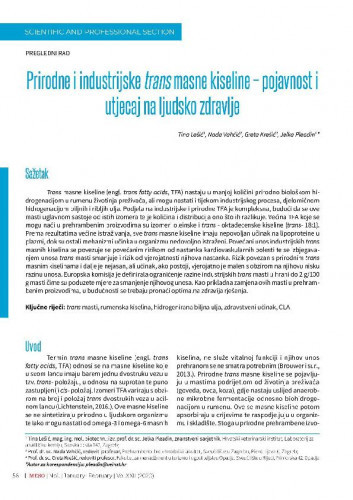Trans masne kiseline (engl. trans fatty acids, TFA) nastaju u manjoj količini prirodno biološkom hidrogenacijom u rumenu životinja preživača, ali mogu nastati i tijekom industrijskog procesa, djelomičnom hidrogenacijom biljnih i ribljih ulja. Podjela na industrijske i prirodne TFA je kompleksna, budući da se ove masti uglavnom sastoje od istih izomera te je količina i distribucija ono što ih razlikuje. Većina TFA koje se mogu naći u prehrambenim proizvodima su izomeri oleinske i trans - oktadecenske kiseline (trans- 18:1). Prema rezultatima većine istraživanja, sve trans masne kiseline imaju nepovoljan učinak na lipoproteine u plazmi, dok su ostali mehanizmi učinka u organizmu nedovoljno istraženi. Povećani unos industrijskih trans masnih kiselina se povezuje se povećanim rizikom od nastanka kardiovaskularnih bolesti te se izbjegavanjem unosa trans masti smanjuje i rizik od vjerojatnosti njihova nastanka. Rizik povezan s prirodnim trans masnim kiselinama i dalje je nejasan, ali učinak, ako postoji, vjerojatno je malen s obzirom na njihovu nisku razinu unosa. Europska komisija je definirala ograničenje razine industrijskih trans masti u hrani do 2 g/100 g masti čime su poduzete mjere za smanjenje njihovog unosa. Kao prikladna zamjena ovih masti u prehrambenim proizvodima, u budućnosti se trebaju pronaći optimalna zdravija rješenja.; Trans fatty acids (TFA) are produced naturally by the biological hydrogenation in the rumen of ruminant animals, but also during the industrial process, by the partial hydrogenation of vegetable and fish oils. The division into industrial and natural TFAs is complex since these fats are mainly composed of the same isomers and the amount and distribution are what differentiate them. Most of the TFA found in food products are oleic and trans-octadecenoic acid isomers (trans-18:1). According to the results of most studies, all TFA have an adverse effect on plasma lipoproteins, while other mechanisms of effect in the human body have been poorly understood. Increased intake of industrial trans fatty acids is associated with an increased risk of cardiovascular disease, and avoiding the intake of trans fat also reduces the risk of such diseases. The risk associated with natural trans fatty acids is still unclear, but the effect, if any, is probably small considering their low intake levels. According to the European Commission, legislation has been adopted on the restricted level of industrial trans fats in food up to 2 g/100 g fat, so that measures to reduce TFA intake have been taken and their levels in food reduced. To replace these fats in food products, optimal healthier solutions need to be found.; Transfettsäuren (engl. TFA) entstehen in geringer Menge auf natürliche Weise durch die biologische Hydrierung im Pansen von Wiederkäuern, aber auch während des industriellen Prozesses, durch die partielle Hydrierung von Pflanzen- und Fischölen. Die Einteilung in industrielle und natürliche TFAs ist komplex, da diese Fette hauptsächlich aus den gleichen Isomeren bestehen und sich durch die Menge und Verteilung unterscheiden. Die meisten Transfettsäuren, die in Lebensmitteln vorkommen, sind Isomere der Olein- und Trans-Octadecensäure (trans-18: 1). Nach den Ergebnissen der meisten Studien haben alle Transfettsäuren eine nachteilige Wirkung auf die Plasma-Lipoproteine, während andere Wirkungsmechanismen im menschlichen Körper unzureichend untersucht wurden. Eine erhöhte Aufnahme von industriellen Transfettsäuren ist mit einem erhöhten Risiko von Herz-Kreislauf-Erkrankungen verbunden; die Vermeidung der Aufnahme von Transfettsäuren reduziert auch das Risiko solcher Erkrankungen. Das mit natürlichen Transfettsäuren verbundene Risiko ist immer noch unklar, aber die Wirkung, wenn überhaupt, ist angesichts der Menge, in der sie in natürlichen Quellen vorhanden sind, wahrscheinlich gering. Die Europäische Kommission hat in ihren Rechtsvorschriften den Gehalt an industriellen Transfettsäuren in Lebensmitteln bis zu 2 g/100 g Fett eingeschränkt, wodurch Maßnahmen zur Verringerung der TFA-Aufnahme ergriffen wurden. Um diese Fette in Nahrungsmitteln zu ersetzen, müssen in Zukunft optimale, gesündere Lösungen gefunden werden.; Gli acidi grassi trans (trans fatty acids, TFA) derivano in minor misura dal processo naturale dell’idrogenazione biologica nel rumine degli animali ruminanti, ma possono venire prodotti anche nel corso del processo industriale dalla parziale idrogenazione degli oli vegetali ed animali. La suddivisione tra TFA industriali e naturali è complessa, giacché si tratta di grassi composti prevalentemente dagli stessi isomeri. Ciò che li distingue è la quantità e la distribuzione. La maggior parte di TFA presenti nei prodotti alimentari sono isomeri dell’acido oleico e trans-ottadecenoico (trans- 18:1). Secondo i risultati della maggior parte delle ricerche svolte in materia, tutti gli acidi grassi trans hanno un impatto negativo sulle lipoproteine nel plasma, mentre gli effetti sugli altri meccanismi dell’organismo umano non sono stati sufficientemente studiati. L’elevata assunzione di acidi grassi trans industriali viene ricollegata al maggior rischio di malattie cardiovascolari. Evitarne l’assunzione riduce la probabilità di riscontrare queste malattie. Il rischio legato agli acidi grassi trans naturali non è ancora stato sufficientemente studiato; in ogni caso il loro impatto, se esiste, è probabilmente minimo considerato il loro basso livello di assunzione nell’organismo umano. La Commissione europea ha stabilito il contenuto massimo ammissibile di acidi grassi trans industriali nei prodotti alimentari in 2 g/100 g di tenore totale di grassi, adottando così misure che riducano la loro assunzione. In futuro è necessario trovare soluzioni ottimali ed innocue per la salute umana che siano in grado di sostituire efficacemente questi grassi nei prodotti alimentari.; Los ácidos grasos trans (inglés trans fatty acids, TFA) están producidos en una pequeña cantidad de forma natural por la hidrogenación biológica en el rumen de los animales rumiantes, pero también durante el proceso industrial, por la hidrogenación parcial de los aceites vegetales y del pescado. La división de los TFA en industriales y naturales es compleja ya que estas grasas están compuestas principalmente de los mismos isómeros, y se diferencian por la cantidad y la distribución. La mayoría de los TFA encontrados en los productos alimenticios son isómeros de ácido oleico y trans-octadecenoico (trans- 18: 1). Según los resultados de la mayoría de los estudios, todos los TFA tienen un efecto adverso sobre las lipoproteínas plasmáticas, mientras que otros mecanismos de efecto en el cuerpo humanos están insuficientemente investigados. El aumento de la ingesta de ácidos grasos trans industriales se asocia con un mayor riesgo de las enfermedades cardiovasculares, y se reduce el riesgo de tales enfermedades evitando la ingesta de las grasas trans. El riesgo asociado con los ácidos grasos trans naturales todavía no está claro, pero el efecto, si existe, probablemente es pequeño dada la cantidad baja de la ingesta. La Comisión Europea ha aprobado el nivel de grasas trans industriales en los alimentos de hasta 2 g / 100 g de grasa, tomando de esta manera la medidas para reducir la ingesta de los TFA. Para reemplazar estas grasas en los productos alimenticios, es necesario encontrar soluciones óptimas y más saludables.
Sažetak

 Meso : prvi hrvatski časopis o mesu : 22,1(2020) / glavna i odgovorna urednica, editor-in-chief Katarina Lučić.
Meso : prvi hrvatski časopis o mesu : 22,1(2020) / glavna i odgovorna urednica, editor-in-chief Katarina Lučić.